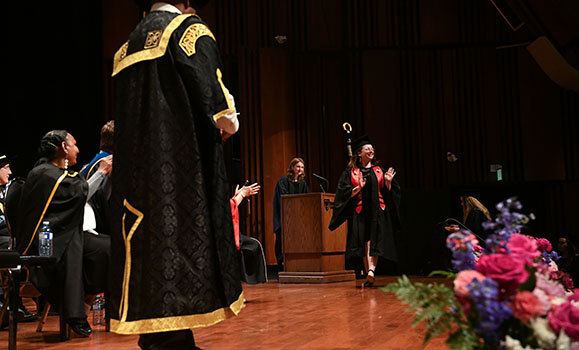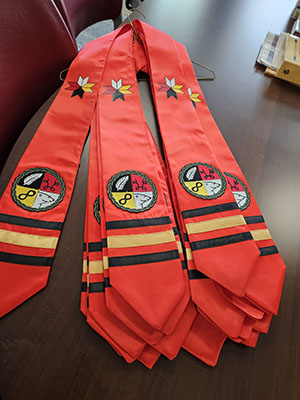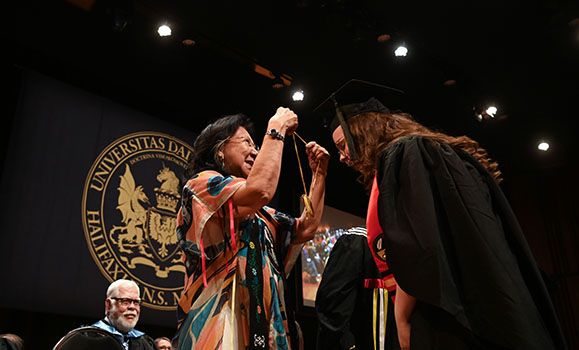Anyone who attended or watched a Convocation ceremony at Dal this spring may have noticed splashes of red amidst the usual sea of black gowns.¬Ý
Among the students adding a crimson hue to the crowd was Kristan Belanger, a Mi‚Äôkmaw student and three-time Dal grad from Glooscap First Nation. While Belanger is no stranger to crossing the stage at Dal, last week marked the first time she did so draped in an Indigenous stole.¬Ý
The stole — a red, scarf-like garment covered in symbols — was newly introduced this year for Indigenous students.
"Being able to walk across the stage wrapped in the stories, the strength, and the identity of my family and my community really reminded me and hopefully others in the crowd that I didn't walk the path of academia alone," she says. "Frankly, I would have never been able to make it to where I am today without the support of my entire community behind me."
¬ÝI would have never been able to make it to where I am today without the support of my entire community
Belanger’s most recent ceremony marked the completion of her Master of Information degree from the Faculty of Management and follows previous degrees in political science (BA’19) and law (JD’22, with Certificate in Indigenous Law).

Belanger waves as she crosses the Convocation stage.¬Ý
She says the stole serves as a visible reminder that Indigenous students persist and achieve across all programs at Dal — significant in an academic space “where our presence is often ignored or erased.”
“Having the visibility of the stole can help reclaim some of that space for ourselves,” she says. “It also hopefully sends a message to future Indigenous students that they also belong here, that their voice matters and their success is possible within academia.”
Pride, achievement, representation
While the neutral black graduation gown has long served as a canvas of sorts, with students adding their own pops of colour and stylistic flourishes, the stole ‚Äî¬Ýlike the kente sashes often worn by students of African descent ‚Äî provides a more formal symbol of recognition and representation.
"It's different when you're watching the students walk in and you see someone wearing the stole and realize, 'Oh, that's an Indigenous student,‚Äô‚Äù says Michele Graveline, one of Dal‚Äôs Indigenous Student Advisors. "It's great when students own that¬Ýin a visual way, the institution sees and those witnessing see that Indigenous students are here, graduating."

Belanger shown in the red stole at her ceremony in the Rebecca Cohn Auditorium alongside fellow Management grads.
Indigenous students at Dal can also receive a medicine pouch along with their parchment during their ceremony, a tradition that’s been offered since 2016. While the stoles must be returned by students with their gown, the pouches are a gift to be kept.
Graveline says she'd love for the university to eventually work towards offering the stole as a keepsake as well in the future.
It's great when students own that and want people to know and to celebrate
The stole‚Äôs striking design emerged from the collaboration of Graveline and other Indigenous colleagues at Dal. Committee members included¬ÝPatti Doyle-Bedwell,¬ÝCatherine Martin, Elder Ann LaBillois, and Brandi Vidovic.
 Red was chosen as the garment’s primary colour given its deep meaning across Indigenous cultures. Although the colour’s meaning varies between nations and regions, it’s often seen as a symbol of vitality, resilience, and growth and can represent a connection to the land or a link to the sacred.
Red was chosen as the garment’s primary colour given its deep meaning across Indigenous cultures. Although the colour’s meaning varies between nations and regions, it’s often seen as a symbol of vitality, resilience, and growth and can represent a connection to the land or a link to the sacred.
The same symbols line both ends of the garment so that when it’s draped around the neck there’s a symmetry between the two sides resting against the chest.
An eight-pointed star sits at the top on each side, with white, yellow, black, and red points. Lower down lies a badge encircled in sweetgrass, one of the primary medicines used in Mi'kma'ki.
The badge is divided into four colour-coded segments:
- An L'nu symbol on a red background to represent the Mi'kmaq.
- A polar bear on a white background to represent the Inuit.
- An infinity symbol on a yellow background to represent Métis.
- A white feather on a black background to represent other First Nations.
Each end finishes with a thick gold stripe couched between two thinner black stripes, representing √€Ã“¥´√Ω's official colours.
"Honour and glow"
Once a design was firmed up, the team tapped local Mi’kmaw craftsperson Roberta Hibbert of The Top Stitch to bring the design to life.
The connection to Hibbert came via Elder LaBillois, √€Ã“¥´√Ω's Elder in Residence. Elder LaBillois had received a custom piece from Hibbert last year to wear during her own graduation ceremony and sought out the artist.
Elder LaBillois, who attends all Convocation ceremonies, says it’s been powerful to see students wearing the new garment during ceremonies this spring.
"As the Indigenous students came walking across the stage with such celebration in their steps, their smiles came from their hearts ‚Äî being able to walk with honour and glow with joy and peace of who you are and to know you belong," she says. "My heart was pounding with pure joy."¬Ý

Belanger receives a medicine pouch from Elder LaBillois during her ceremony.

